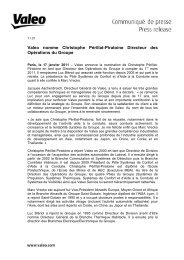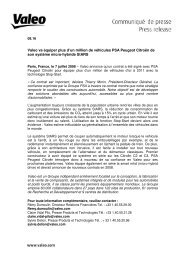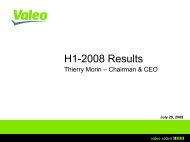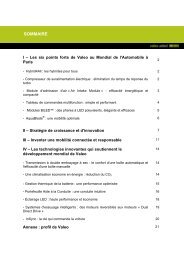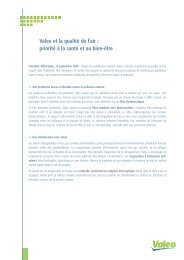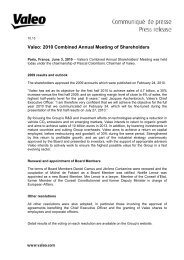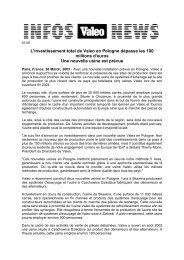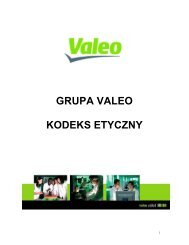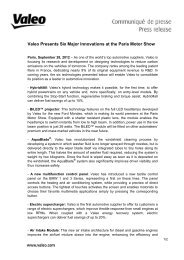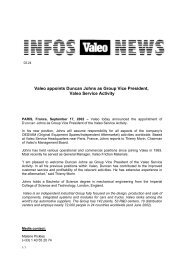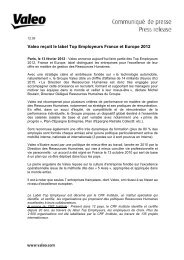2007 Reference document (PDF) - Valeo
2007 Reference document (PDF) - Valeo
2007 Reference document (PDF) - Valeo
Create successful ePaper yourself
Turn your PDF publications into a flip-book with our unique Google optimized e-Paper software.
1 Activity<br />
The Group<br />
PAGE 24<br />
■<br />
■<br />
The specific features of the aftermarket are also taken into<br />
account at <strong>Valeo</strong>. This market imposes certain limitations on<br />
industrial operations. Products are mainly manufactured using<br />
the same production machines as for original equipment parts.<br />
If necessary, simplified lines designed for small volumes with low<br />
levels of automation can meet the requirements of this market.<br />
Servicing and maintenance of these specific machines are already<br />
in place.<br />
In order to optimize logistics, each <strong>Valeo</strong> plant is organized according<br />
to product flow. Responsiveness and flexibility with regard to<br />
customers’ requirements are fundamental. In particular, <strong>Valeo</strong><br />
employs pull-flow methods to reduce stocks and simultaneously<br />
improve customer service levels. Two new techniques were<br />
applied in <strong>2007</strong>: “the truck image” whereby orders are prepared<br />
in sequence to eliminate futile stock movements and “visual reordering”<br />
which reduces component stock levels, especially for<br />
shipping flows. The daily measuring of service levels is a rule<br />
which, little by little, is extending to our suppliers.<br />
4.3.3. Quality<br />
Quality is a key demand from consumers and automakers.<br />
It is the cornerstone of <strong>Valeo</strong>’s 5 Axes methodology, and an<br />
integral part of the Group’s culture.<br />
Total Quality is not just a question of methodology; it is above all<br />
a state of mind. It therefore requires the involvement of everyone<br />
at all times and in all circumstances. At <strong>Valeo</strong>, this approach is the<br />
responsibility of all 61,200 Group employees.<br />
■<br />
■<br />
−<br />
−<br />
−<br />
The role of the Quality network is to ensure that everyone is aware<br />
of and understands their individual responsibilities. It also consists<br />
of evaluating problems and requirements in terms of training<br />
support, and of training, supporting and validating lessons to be<br />
retained and shared to avoid any recurrence.<br />
The <strong>Valeo</strong> Quality network functions on the basis of a decentralized<br />
network and involves each of the 5 Axes:<br />
the Quality System Manager validates internal procedures, checks<br />
that they are applied properly, and updates them to ensure<br />
that they are in line with both internal and external quality<br />
standards,<br />
the Project Quality Manager ensures that the quality methodology<br />
is duly applied to projects and checks that projects are covered for<br />
their entire duration, in accordance with <strong>Valeo</strong> standards,<br />
the Supplier Quality Manager manages the quality of components<br />
delivered, from the project phase right through the product’s<br />
lifecycle and assists supplier progress through the implementation<br />
of improvement plans,<br />
<strong>2007</strong> <strong>Reference</strong> <strong>document</strong> - VALEO<br />
−<br />
the Production Quality Manager ensures that quality-specific tools<br />
are properly implemented within the manufacture process and<br />
coordinates the deployment of control plans as well as instructions<br />
for work. He/she also acts as the “voice of the customer” for<br />
all quality incidents in order to ensure the customer’s total<br />
satisfaction;<br />
■ <strong>Valeo</strong> has also implemented a program of resident engineers,<br />
to provide optimal customer support. Engineers are no longer<br />
simply assigned to a given customer; they actually go and work<br />
at the customer’s premises. As soon as a problem is detected, the<br />
engineer communicates it to the appropriate people at <strong>Valeo</strong>, so<br />
that actions can be defined immediately to protect the customer.<br />
At the end of <strong>2007</strong>, the Group had 72 resident engineers; 46 in<br />
Europe, 15 in North America, 8 in Asia and 3 in South America.<br />
Among these 72 people, a program of warranty resident engineers<br />
was also deployed, whereby 10 resident engineers joined the<br />
customer teams, either at the head offices or in their warranty<br />
management centers.<br />
Reinforcing the <strong>Valeo</strong> culture means mobilizing all employees at all<br />
levels, and is based on:<br />
■<br />
■<br />
■<br />
< Contents ><br />
the San Gen Shugi approach, inspired by Japanese best practices<br />
and based on a concrete analysis of what actually happens on<br />
the shop floor. San Gen Shugi is based on reality: Gen-ba (where<br />
and when a problem arises) Gen-butsu (using the actual parts<br />
involved, whether above or below standard), Gen-jitsu (with<br />
measurable facts). This attitude is founded on both individual<br />
responsibility and teamwork;<br />
the QRQC approach (Quick Response Quality Control) is also<br />
essential. When a problem occurs it is immediately identified<br />
and analyzed by the parties involved. Corrective action is defined<br />
immediately and implemented within 24 hours. In the event of<br />
a quality incident, meetings are held on the spot, to identify the<br />
root cause and eliminate it for good. These meetings involve<br />
employees from various functions as required: production,<br />
logistics, maintenance, etc.;<br />
in the automotive industry, non-quality of products is expressed<br />
in ppm (the number of defective parts per million produced).<br />
In four years, <strong>Valeo</strong> has reduced the number of defective parts<br />
by a factor of 18. In <strong>2007</strong>, non-quality of products improved by<br />
29% compared to 2006, to reach 10 ppm at the end of <strong>2007</strong><br />
(compared to 14 at the end of 2006). 86 <strong>Valeo</strong> sites (compared<br />
to 55 at the end of 2006) were already below 10 ppm at the<br />
end of <strong>2007</strong>.<br />
1<br />
2<br />
3<br />
4<br />
5<br />
6




